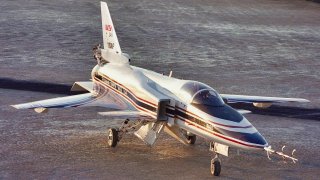The Grumman X-29 Is A Backwards Looking Plane for a Reason
The Grumman X-29 is one of the more obscure experimental aircraft in aviation history that failed to make it past the testing phase.
The Grumman (now Northrup Grumman, most famous for being the manufacturer of the F-14 Tomcat) X-29 is one of the more obscure experimental aircraft in aviation history that failed to make it past the testing phase, ergo nowhere near famous as other weapons ending in “29,” such as the B-29 Superfortress or Dirty Harry’s Smith & Wesson Model 29 .44 Magnum. But that doesn’t make it any less exciting or worthy of an article.
Let’s take a closer look at the history of this short-lived bird:
X-29: One Short of a Dirty Thirty
The X-29 made her maiden flight of December 14, 1984, piloted by Grumman Chief Test Pilot Chuck Sewell out of Edward AFB, California.
It was an experimental aircraft that tested a forward-swept wing, canard control surfaces, and other novel aircraft technologies.
Two were built, which were flown by NASA and the U.S. Air Force, and received additional funding from DARPA (the Defense Advanced Research Projects Agency).
The X-29 was the third forward-swept wing jet-powered aircraft design to fly; the other two were the Luftwaffe’s Junkers Ju 287 jet bomber (1944) and the HFB-320 Hansa Jet aka the “German LearJet” (1964).
On December 13, 1985, it became the first forward-swept wing aircraft to fly at supersonic speed in level flight. The Ju287 encountered problems with the metal wings bending dangerously at higher speeds. However, as stronger composite materials became available in the 1970s, wing structures could be both lightweight and very rigid, and the X-29 was built to “Carpe Diem” on these technological advancements.
The aerodynamic instability of the X-29's airframe required the use of computerized fly-by-wire control. The silver lining behind the proverbial “cloud” of this instability was wide predictions providing extreme maneuverability.
However, as noted by the official NASA Fact Sheet on the X-29, “The X-29 did not demonstrate the overall reduction in aerodynamic drag that earlier studies had suggested. The X-29 program did demonstrate several new technologies as well as new uses of proven technologies including aeroelastic tailoring to control structural divergence and use of a relatively large, close-coupled canard for longitudinal control. In addition, the program validated control of an aircraft with extreme instability while still providing good handling qualities; use of three-surface longitudinal control; use of a double-hinged trailing-edge flaperon at supersonic speeds; control effectiveness at high angles of attack; vortex control; and military utility of the overall design.”
“Trust No One *Under* 30?”
The two X-29 aircraft flew a total of 242 times from 1984 to 1991. The first of the two specimens, 82-003, was put on post-retirement display at the Research and Development Gallery of the National Museum of the United States Air Force on Wright-Patterson AFB near Dayton, Ohio in late 1994.

The other craft found its own retirement home at the Armstrong Flight Research Center on Edwards Air Force Base. And for the benefit of our readers who don’t have either the time and/or money and/or desire to make a trip to the West Coast or the Midwest anytime soon, you’re still in luck, as the Cradle of Aviation Museum in Garden City, New York has hosted a full-scale replica of the X-29 since 2011.
Specifications
Crew: 1
Capacity: 4,000 lb (1,814 kg) payload
Length: 53 ft 11.25 in (16.4402 m) including nose probe
48 ft 1 in (15 m) fuselage only
Wingspan: 27 ft 2.5 in (8.293 m)
Height: 14 ft 3.5 in (4.356 m)
Wing area: 188.84 sq ft (17.544 m2)
Empty weight: 13,800 lb (6,260 kg)
Max takeoff weight: 17,800 lb (8,074 kg)
Maximum speed: 956 kn (1,100 mph, 1,771 km/h) at 33,000 ft (10,058 m)
Maximum speed: Mach 1.6
Range: 350 nmi (400 mi, 650 km)
Service ceiling: 55,000 ft (17,000 m)
About the Author
Christian D. Orr is a former Air Force officer, Federal law enforcement officer, and private military contractor (with assignments worked in Iraq, the United Arab Emirates, Kosovo, Japan, Germany, and the Pentagon). Chris holds a B.A. in International Relations from the University of Southern California (USC) and an M.A. in Intelligence Studies (concentration in Terrorism Studies) from American Military University (AMU). He has also been published in The Daily Torch and The Journal of Intelligence and Cyber Security.
All images are Creative Commons.


